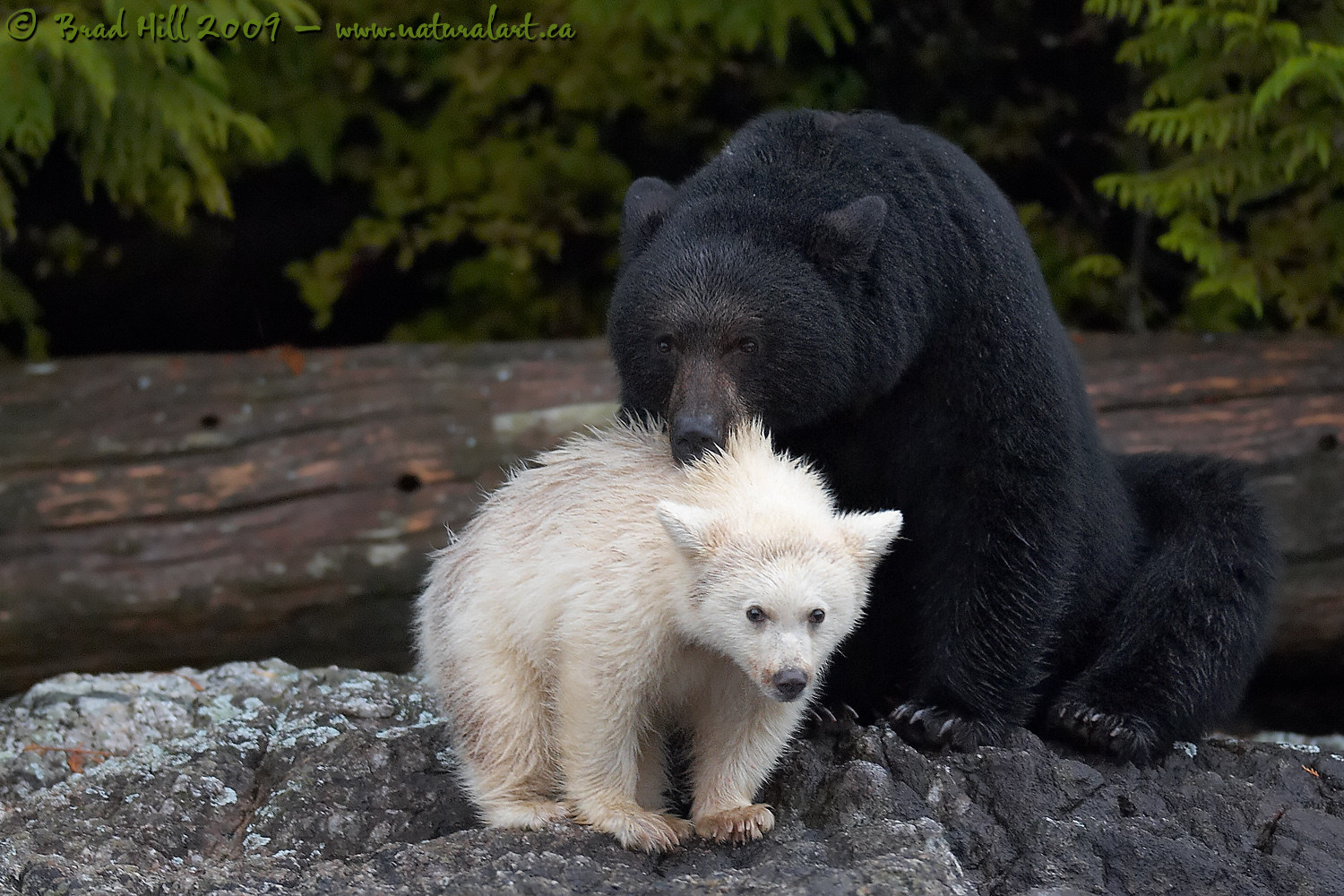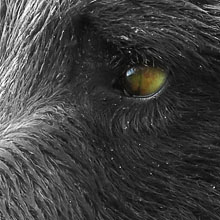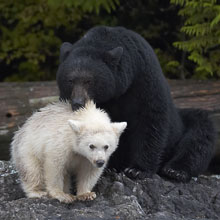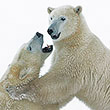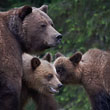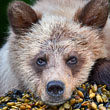Availability: Limited Edition Print
In the Field
Black and White - Harmony. Great Bear Rainforest (northern BC coast), Canada. October 11, 2007.
This is a shot of an affectionate female Black bear with her "Spirit Bear" cub. Spirit Bears are also known as "Kermode" bears and they are a very rare colour-variant. Their white coats have a genetic basis - the white coat is seen only when the bearer has two copies of the same recessive gene (the white coat is recessive to the normal black or dark pelage). So the little cub pictured here has two copies of the recessive gene. The mother bear MUST be a carrier of the trait, i.e., she must possess both the dominant version and the recessive version of the gene. This female had two cubs until shortly before this image was shot (we have no idea what happened to the other cub but suspect another adult black bear - likely a male - dispatched of it) and the OTHER cub was white as well. So it is very likely that the father was another white Spirit Bear.
While I know I'm guilty of anthropomorphism with this next statement, it seemed to us that the female was acting almost sad - presumably because of the loss of the other cub. She was definitely both possessive and protective of this little cub!
From a photographic perspective, it was a HUGE challenge to capture this image. It was late in the day and raining heavily - there was almost NO light! We were shooting from a inflatable Zodiac that was rocking in the waves and with its motor running (adding additional vibration). How did I get the image? Several factors contributed: lots of luck; a very fast telephoto lens (f2); effective Vibration Reduction on the lens; and, last but not least, a high ISO setting. Not a technically great image...but I got it and, have to admit, I quite like it!
NOTE: This image was awarded the "Wildlife Image of the Year" by the Nature Photographer's Online Magazine - the world's leading online nature photography community.
ADDITIONAL NOTES:
1. This image - in all resolutions - is protected by copyright. I'm fine with personal uses of them (including use as desktop backgrounds or screensavers on your own computer), but unauthorized commercial use of the image is prohibited by law. Thanks in advance for respecting my copyright!
2. This image was captured during one of my two spring "Grizzlies of the Khutzeymateen" photo tours in May/June of 2009. Each year I offer trips into two different parts of the Great Bear Rainforest as well as one to photograph aquatic mammals and oceanscapes near the northern tip of Vancouver Island. And, in selected years, I also offer photo tours to locations to capture other highly sought-after subjects, such as various boreal owl species and wildlife of Canada's Arctic. Details about these trips can be found on the Photo Tours page of this website.
3. Like all wildlife photographs on this website, this image was captured following the strict ethical guidelines described in The Wildlife FIRST! Principles of Photographer Conduct. I encourage all wildlife photographers to always put the welfare of their subjects above the value of their photographs.
Behind the Camera
Black and White - Harmony. Great Bear Rainforest (northern BC coast), Canada. October 11, 2007.
Digital Capture; Uncompressed RAW (NEF) format; ISO 500.
Nikon D2Xs with Nikon 200mm f/2G ED-IF AF-S VR lens (300 mm equivalent with digital conversion factor) - handheld. VR turned to "On" and in "Active" mode. AquaTech SportShield (rain cover) used to protect camera and lens.
1/90s @ f2; -1.0 stop compensation from matrix-metered exposure setting.
At the Computer
Black and White - Harmony. Great Bear Rainforest (northern BC coast), Canada. October 11, 2007.
RAW Conversion to 16 bit TIFF, including first-pass sharpening and exposure compensation using Phase One's C1 Pro. Multiple RAW conversions (2 at different exposure settings) in this case to adjust shadow and highlight detail (see below).
Further digital correction on 16-bit TIFF file using Adobe's Photoshop CS3 and LightZone 3. Minor tonal adjustments performed in LightZone (using the ToneMapper/Relight tool). Photoshop adjustments included compositing and masking of two exposure vesions (primarily to retrieve shadow detail on the black mother bear), selective saturation enhancement, selective noise reduction (using PictureCode's Noise Ninja plug-in for Photoshop) and selective sharpening for web output.
Conservation
Black and White - Harmony. Great Bear Rainforest (northern BC coast), Canada. October 11, 2007.
Ten percent of the revenue generated by this image will be donated to Raincoast*.
Species Status in Canada**: Not currently listed as Threatened or Endangered.
The "Spirit" Bear is a rare genetically-based colour variant of the common Black Bear (Ursus americana). It has been estimated that less than 300 Spirit Bears exist today. Because the Black Bear is not considered under threat as a species, the Spirit Bear suffers from having the same conservation designation (it should be acknowledged that in British Columbia - the jurisdiction of greatest Spirit Bear abundance - hunting of these white-coated bears is not permitted). For reasons that are not fully understood, the Spirit Bear occurs with greater frequency in a relatively small geographic area within The Great Bear Rainforest of the central and northern coast of British Columbia. In this area 10 to 30% of the bears possess white coats. Many of the black-coloured Black Bears in this region carry the gene for white coats, so allowing hunting of ANY Black Bears in this region can reduce the frequency of the gene for white coats. Thus, to protect the Spirit Bear, it is necessary to prohibit the hunting of ALL Black Bears in this region. And, very unfortunately, the globally unique ecosystem that contains the Spirit Bear is under development pressure, especially from the forestry industry. If this unique environment is altered, we may lose the wonderful genetic anomaly known as the Spirit Bear forever.
*The Raincoast Conservation Society (and Foundation) is an effective and efficient organization that has been fighting for protection of this unique habitat. If you are looking for a meaningful way to contribute to the conservation of this amazing ecosystem, Raincoast will provide maximal "bang" for your conservation dollars.
**as determined by COSEWIC: The Committee on the Status of Endangered Wildlife in Canada












